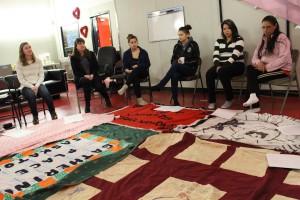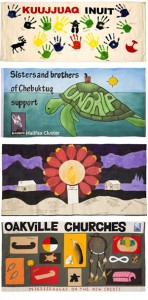The Blanket Exercise: walk in someone else’s shoes all the way back to the first meetings of Europeans and Indigenous Peoples

“You can’t understand a person until you have walked a mile in their shoes,” goes the old saying. I’ve never believed it, really. I can grasp the principle, but I don’t believe you can fully live in another person’s circumstances or truly feel the burden or barriers they might feel. If I don’t like the walk, I can quit; but the owner of the shoes must keep walking.
Yet, that’s not to say that a few steps in someone else’s shoes won’t make you squirm a little. The “Blanket Exercise” will get you, for a time at least, walking in someone else’s shoes, and will raise your awareness and understanding of Aboriginal, Metis and Inuit people in Canada.
As the name suggests, the Blanket Exercise begins with blankets arranged on the floor to represent Canada before the arrival of Europeans. Participants represent either Indigenous people or Europeans. When the exercise starts, the only participants on the blankets are those representing Indigenous people with their thriving culture in what we now call North America. Participants representing Europeans arrive, bringing with them a kind of cultural arrogance and the assumption that the raw landscape and uncivilized people must be fashioned into something European if they are to have real value. What follows in the exercise is the steady shift from Indigenous people covering the land to Europeans covering the land. Finally, Indigenous people—their populations decimated—live on small reserves.
With even a rudimentary knowledge of Canadian history, we know that Indigenous people, “Indians,” were here long before white people began to arrive. We know that through a series of negotiations, deals were made, treaties were signed and reserves were established. We might suspect that the negotiations were not always done in good faith, but we don’t usually have to walk a mile in the shoes of an Indigenous person, so we don’t have to confront those questions.
The “Blanket Exercise” is a walk in someone else’s shoes all the way back to the first meetings of Europeans and Indigenous people. From there, it is deeply disturbing to watch the Beothuk people of what is now Newfoundland eliminated from the game as they were hunted to extinction. Troubling, too, is the act of folding your blanket—your land—in half then in half again as your traditional land shrinks to a small reserve—all according to legal negotiating in someone else’s language. Perhaps most troubling of all is to receive an apparently gracious gift of a thick, wool Hudson’s Bay blanket that is laced with the smallpox virus. Those still on a blanket at the end of the game are reminded that they live amid higher poverty rates than the rest of Canada, and suffer a lack of clean drinking water, inadequate housing, lower education levels and disproportionate incarceration rates.
I have seen the “Blanket Exercise” twice. In this way, I’ve walked in someone else’s shoes—and to be blunt, I didn’t like it. But here’s the rub—I can’t quit the walk. I am Canadian. So are Indigenous people. Realize it or not, like it or not, we are walking together and if not in the same shoes, then on the same land. We have to find better ways to live together.
In a peculiar way, the “Blanket Exercise” offers hope. Participants will gain a better understanding of our Indigenous fellow Canadians. Understanding can lead to compassion. Understanding can lead past stereotypes and to real people who have much to offer. Understanding can help us to deal with the past and move into the future. It starts by walking a mile in someone else’s shoes, or at least walking far enough together to squirm a little.
The “Blanket Exercise” is available through Kairos Canada and comes with a complete, ready-to-use script. You will need to supply the blankets, but with that preparation, it can be used with any number of people of any age. Consider using it at your school, church, retreat or virtually any setting.
(Many thanks to Rev. Korver and the Committee for Contact with the Government of the Christian Reformed Church for their generous permission to reprint this article from “Mobile Justice”, May 2010. The original can be found at http://www.crcna.org/pages/ccg_mj_1005_aboriginal.cfm )









